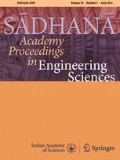Abstract
The inverted pendulum system in the presence of uncertainties and external disturbances with delay is considered as one of the most applicable nonlinear systems to be used in real environments and industrial domains, extensively. The subject behind the research is to design a state-of-the-art fractional-order sliding mode control approach to stabilize the inverted pendulum angle. Subsequently, a consideration of uncertainties and external disturbances in the pendulum dynamic’s parameters such as pendulum length and chariot’s mass aims us to find an efficient technique to decrease chattering and correspondingly increase system’s performance as well. In addition, the Smith predictive model representation along with the control approach is realized as a solution of eliminating time delay. In a word, the realization of sliding mode control to deal with uncertainties and external disturbances in line with an application of fractional-order sliding surfaces for decreasing chattering under the aforementioned Smith predictive model representation to eliminate delay is taken into real consideration as remarkable novelty of research proposed. Finally, the effectiveness of the approach analyzed here is verified in the form of numerical simulations through MATLAB software, tangibly.





References
Fantoni I, Lozano R, and Spong M W 2000 Energy based control of the pendubot. IEEE Trans. Automat. Contr. 45 (4): 725–729
Acosta J A 2010 Furuta’s Pendulum: A conservative nonlinear model for theory and practice. Math. Probl. Eng. 2010 Article ID 742894
Block D J, Åström K J and Spong M W 2007 The reaction wheel pendulum. Synth. Lect. Control mechatronics 1 (1): 1–105
Åström K J, Klein R E and Lennartsson A 2005 Bicycle dynamics and control. IEEE Control Syst. Mag. 25 (4): 26–47
Martin P, Devasia S and Paden B 1996 A different look at output tracking: control of a VTOL aircraft. Automatica 32 (1): 101–107
Åström K J and Furuta K 2000 Swinging up a pendulum by energy control. Automatica 36 (2): 287–295
Yoshida K 1999 Swing-up control of an inverted pendulum by energy-based methods. American Control Conference 6: 4045–4047
Furuta K, Okutani, T and Sone H 1978 Computer control of a double inverted pendulum. Comput. Electr. Eng. 5 (1): 67–84
Bortoff S A 1996 Robust swing-up control for a rotational double pendulum. IFAC Proc. 29 (1): 2810–2815
Tsai M C and Shen B H 2007 Synchronisation control of parallel dual inverted pendulums driven by linear servomotors. IET Control Theory Appl. 1 (1): 320–327
Furut K, Ochiai T and Ono N 1984 Attitude control of a triple inverted pendulum. Int. J. Control. 39 (6): 1351–1365
Li H, Zhihong M and Jiayin W 2002 Variable universe adaptive fuzzy control on the quadruple inverted pendulum. Sci. China Ser. E Technol. Sci. 45 (2): 213–224
Shen J, Sanyal A K, Chaturvedi N A, Bernstein D and McClamroch H 2004 Dynamics and control of a 3D pendulum. IEEE Conference on Decision and Control 1: 323–328
Lai C L and Hsu P L 2010 Design the remote control system with the time-delay estimator and the adaptive Smith predictor. IEEE Trans. Ind. Informatics 6 (1): 73–80
Huzmezan M, Gough W A, Dumont G A and Kovac S 2002 Time delay integrating systems: a challenge for process control industries. A practical solution. Control Eng. Pract. 10 (10):1153–1161
Normey-Rico J E, Bordons C and Camacho E F 1997 Improving the robustness of dead-time compensating PI controllers. Control Eng. Pract. 5 (6): 801–810
Wu T S and Karkoub M 2014 H∞ fuzzy adaptive tracking control design for nonlinear systems with output delays. Fuzzy Sets Syst. 254: 1–25
Aghababa M P and Akbari M E 2012 A chattering-free robust adaptive sliding mode controller for synchronization of two different chaotic systems with unknown uncertainties and external disturbances. Appl. Math. Comput. 218 (9): 5757–5768
Li H S, Luo Y and Chen Y Q 2010 A fractional-order proportional and derivative (FOPD) motion controller: Tuning rule and experiments. IEEE Trans. Contr. Syst. Tech. 18 (2): 516–520
Author information
Authors and Affiliations
Corresponding author
Rights and permissions
About this article
Cite this article
Zangeneh-Madar, M.R., Mazinan, A.H. Control of the inverted pendulum system: a Smith fractional-order predictive model representation. Sādhanā 45, 105 (2020). https://doi.org/10.1007/s12046-020-01356-8
Received:
Revised:
Accepted:
Published:
DOI: https://doi.org/10.1007/s12046-020-01356-8

